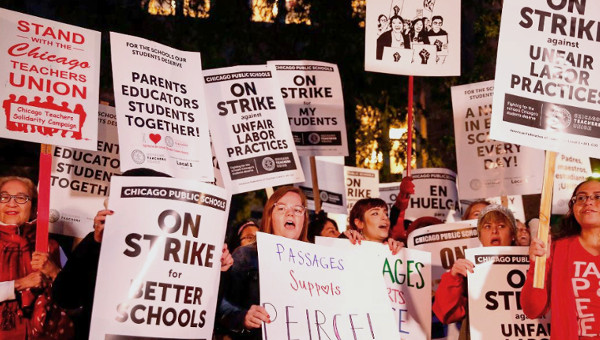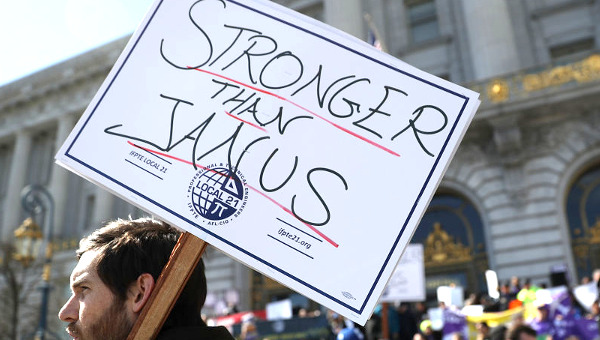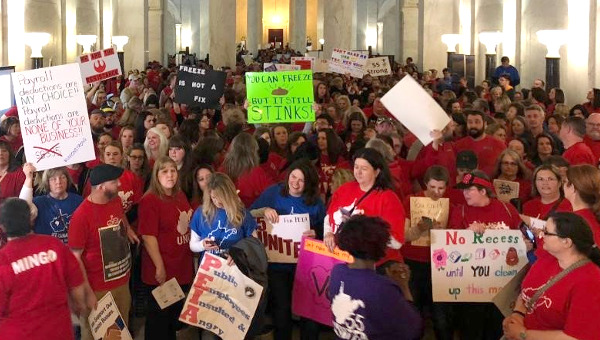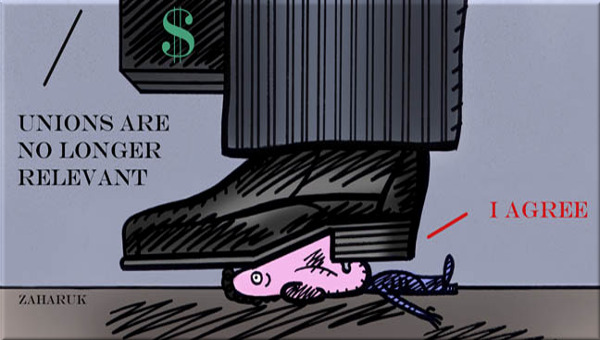Teachers Lead in the Revolt Against Austerity
In less than three months, rank-and-file teachers and educational support staff in five states – West Virginia, Kentucky, Oklahoma, Colorado and Arizona – have turned the entire country into their classroom. They haven’t just pushed for – and won – better pay and working conditions for themselves. They’ve also mounted a direct challenge to decades of bipartisan tax cuts for corporations, helping us all understand what austerity means. And by championing a raft of policy proposals to redistribute wealth away from the 1 per cent and back to the working and middle-class, they’ve shown us how austerity can be defeated.

As Emily Comer, a middle-school Spanish teacher who was a leader in the strikes in West Virginia, put it, “The phase we are in now – to win a real, progressive solution to the health-insurance crisis – forces us to dream bigger. This isn’t just about our healthcare plan. It’s about rebalancing the power of workers and corporations in our state.”
Remarkably, these strikes have garnered overwhelming support from the public, despite years of well-funded attacks on teachers’ unions. In a recent NPR/Ipsos poll, just one in four respondents said they think teachers are paid enough, and three-quarters said teachers have the right to strike. Remarkably, this support cut across party lines. “Two thirds of Republicans, three-quarters of independents and nearly 9 in 10 Democrats” support the teachers’ right to strike, the poll showed.
The most recent walkouts have shifted to western states. On April 26, 50,000 teachers and their supporters marched through Phoenix in 100 degree heat. That same day, thousands of protesters descended on the capitol of Colorado.
Walkouts and Victories
Every walkout has resulted in victories, some more than others. In Kentucky, educators forced the governor’s veto of new taxes to be overturned, providing some additional funds for schools. But they fell short of preventing the conservative legislature from weakening their pension plan. In Oklahoma, while educators failed to stop a raft of tax cuts and increase overall funding, they still won their first raise since 2007 by $6,000 a year, which by is huge by local standards. In Arizona, the teachers won a 9 per cent immediate raise, with Governor Doug Ducey pledging 11 per cent more to achieve what he calls the 2020 deal, a 20 per cent pay raise for all teachers by 2020. Governor John Hickenlooper, the only Democrat to head one of these states, responded to thousands of protesters by committing to restore $1-billion in education funding.
The two fiercest fights in the rebellion thus far have been in West Virginia and Arizona. In both states, the struggle hasn’t been only, or even mostly, over teacher pay; it’s been about the very future of public education. In both states, vouchers and privatization of public education have been front and center. In West Virginia, strikers defeated a move to gut seniority and a proposal to expand charter schools.
In Arizona, the fight is about “whether there will be brick-and-mortar schools in the near future,” says education journalist Jennifer Berkshire. Long a laboratory for right-wing education policies, the state has the highest percentage of students in charter schools (17 per cent) in the nation. “Arizona is ground zero for the Koch Brothers and Betsy DeVos,” Berkshire notes, “They’ve rolled out something they call education savings accounts [ESAs]. Bank of America has a contract to create a debit card for parents to use for homeschooling, private tutors, school supplies, or a down payment on private-school tuition.” Of course, DeVos herself is frequently heard – as she was during a recent disastrous interview with Leslie Stahl on 60 Minutes – repeating a version of her mantra, “What’s an education ‘system’? There’s no such thing! Are you a system? No, you’re individual students, teachers, and parents.”
Arizona’s #RedForEd movement sprung up last year, after a coalition called Save Our Schools formed when Governor Doug Ducey pushed through an ESA pilot program. Started by parents, Save Our Schools has gathered enough signatures to place a question on the November ballot to roll back the ESA program entirely. By day two of the teacher walkouts, a second ballot initiative was drafted to create a new, dedicated tax to fund public schools; signature gathering is under way. Winning either initiative will be a heavy lift, in part because of the Koch Brothers’ opposition. But the massive turnout in favor of the teacher strike – the first statewide strike in Arizona history, and an illegal one at that – has Joe Thomas, the head of the Arizona Education Association, feeling optimistic. “It’s been an amazing two days, with educators by the tens of thousands walking out of their classrooms and into the state capitol,” he said. “We love this energy!”
In West Virginia, the strike settlement included the creation of a task force to come up with a long-term solution to rapidly rising health-insurance costs facing not just teachers but all state workers. The Public Employees Insurance Agency Task Force (PEIA), which includes representatives from all three education unions, was created in the heat of the strike by an executive order from the governor. But once the media turned their attention away, Governor Jim Justice tried to undo the part of the order that mandated 55 public hearings in all 55 counties. “To us, the hearings were a key part of the executive order because it gives our community the right to be heard in designing the largest healthcare plan in our state,” Comer says. “We immediately started an action plan, generating 350 letters in a week, demanding they restore the public-hearing process. We wound up winning back what will be a total of 21 public hearings across the state. That was definitely a win.” Perhaps more importantly from an organizing perspective, the task force puts into place a mechanism to continue building power on a key issue, while also allowing educators to get back to work educating.
The first PEIA hearing was on May 1, and workers are advancing a series of corporate tax increases to generate a long-term revenue stream for healthcare. Ted Boettner, the executive director of the West Virginia Center for Budget and Policy, has already analyzed which tax increases will generate what levels of revenue. “The reason PEIA is in this crisis is because then Democratic Governor Joe Manchin lowered taxes by $420-million, getting rid of the business franchise tax and slashing the corporate net income tax from 9 per cent to 6.5 per cent,” says Boettner. “We’ve got several options, including raising the gas severance tax from 5 to 7.5 per cent, which will yield $86-million in FY 2020 and $115-million by FY 2023. In addition, we should restore the corporate net income tax to 9 per cent, which would yield $62-million in 2020 and $83-million in 2023.”
Jay O’Neal, the treasurer of the Kanawha County chapter of the West Virginia Education Association and a key strike leader, reports that at the April 26 delegate assembly, “We unanimously passed a resolution calling for the funding to come from this combination of taxes, and explicitly endorsed progressive taxation as the solution.”
On the Horizon…
With the school year winding down, the next teachers strike might be in North Carolina in mid-May, when the state legislature resumes session. On the horizon, however, is the real possibility that the rebellion will rise up next in blue (Democratic Party) state California. Teachers in Los Angeles, the second-largest school district in the country, are already assessing the membership’s willingness to start the next school year on strike if an agreement isn’t reach by June. “This isn’t a red state issue, it’s a blue state issue too,” says Alex Caputo-Pearl, the president of the United Teachers of Los Angeles. “The rank and file are going to take the fight to the Democrats who have been complicit in the attack on public education and teachers unions.” According to Caputo-Pearl, California ranks 46th in per pupil spending, and his school district is “spending $1-billion of its $6.4-billion budget on special education to cover the shortfall in federal funding for kids with special needs.” Caputo-Pearl also notes that over the past 10 years, a “287 per cent increase in private charter schools in LA has diverted $600-million per year from neighborhood schools.”
We are used to seeing dramatic inequalities between school districts in red states, but according to a new report issued by the Rutgers Graduate School of Education, California (like Mississippi and Alabama) is one of several states in which “the highest poverty school districts fall as much as $14,000 to $16,000 per pupil below the necessary spending levels.” UTLA has a multi-pronged approach to ending this blue-state austerity, all of which involves taxing corporations and the super wealthy.
Caputo-Pearl says they are working closely with a broad coalition of smart and determined community groups on several revenue-raising strategies. “First up is we are working on the Schools and Communities First Initiative, collecting signatures for a 2020 ballot initiative to close the corporate loophole in Prop 13,” he says. “When we win this, it will generate $11-billion annually, and the measure calls for $5-billion of that to go to public education. We have also gotten Assembly Bill 2731 introduced, which closes the federal loophole Trump put into the federal tax cut by placing a tax surcharge on hedge fund and private-equity managers in California. It will put $1-billion into education.”
The coalition advancing the 2020 ballot is headed by Anthony Thigpenn, who led one of the groups that got a millionaires’ tax passed by citizen ballot in California in 2012. The initiative hasn’t attracted nearly the attention it deserves: it flipped the sixth largest economy in the world from billions in the red to restoring billions in cuts in one year and created enough revenue to restart a rainy-day fund. “In 2012, the conventional wisdom said we couldn’t win new taxation. There’s a dominant narrative that Americans are anti-tax, but we proved the pundits wrong,” Thigpenn says. “When we help people connect decades of tax cuts to their kids schools falling apart and a dearth of affordable housing or healthcare, they will in fact vote to tax corporations again.”
“When we help people connect decades of tax cuts to their kids schools falling apart and a dearth of affordable housing or healthcare, they will in fact vote to tax corporations again.”
Such blue-state activism (and intra-Democratic Party feuding) was presaged by Massachusetts in 2016, when the Massachusetts Teachers Association (MTA) defeated a ballot measure that would have greatly expanded charter schools. A whopping $35-million in favor of the measure poured in from hedge funds and private-equity groups. But in the end, the teachers – who took a gamble by not coming to a legislative compromise that would have stopped the ballot in exchange for less charter expansion – defeated the measure by an almost 2-to-1 margin.
The 113,000-member MTA was headed by a left-leaning rank and file president, Barbara Madeloni, who had to overcome skeptics inside her own union who feared the public wouldn’t back teachers. Madeloni herself ran for president after being inspired by the 2012 Chicago Teachers Union (CTU) strike, which came about after a slate of younger, more diverse teachers won election to CTU’s highest posts in 2010. Caputo-Pearl and a team of progressively minded teachers in California were next to win.
Movement for Change: Using the Strike Weapon
These union leaders represent a movement for change toward a more visionary, progressive teacher unionism – one that is continuing to grow. On May 5, in an election to succeed Madeloni, a progressive slate of candidates swept the MTA’s top offices. “The teacher members didn’t just vote for progressive candidate,” says incoming MTA president Merrie Najimy, “they voted decisively… to endorse an all-out commitment to support the ballot referendum this fall which proposes to tax millionaires, with the income dedicated to public education and transportation.”
Several key differences in approach distinguish this new leadership. The most important is their strong belief in using the strike weapon. The dynamism of the new teacher movement flows from the methodical work required to hold effective strikes because a strike’s success is predicated on workers being in control and making real decisions about their future. Another characteristic of this new generation is that they understand challenging corporate Democrats isn’t an option, it’s essential.
To continue this spring’s momentum, and increase turnout for the midterm elections, two things are urgently needed. First, national and state-level teacher union officials must embrace this rank-and-file movement. There’s no better way to build the kind of workplace organization needed to stave off the coming blow from the Supreme Court in the Janus case than supporting this robust movement from below. This will necessarily include breaks with Democrats who have been virtually as complicit in the charter-school movement as DeVos and the Koch Brothers.
Second, the broader progressive movement must make the teacher union fight our fight. If you believe in society, in public education, in the idea of the collective, then embracing teacher unions and all public-service-worker unions is essential. It’s time to dream big. •
This article first published by The Nation.





